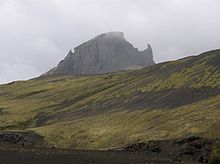Palagonite

Palagonite is a completely devitrified , yellowish-brown, former rock glass that was created from basaltic lava . It is named after the place Palagonia in Sicily and forms an important part of the palagonite tuff.
Emergence
Palagonite is formed by the process of palagonitization, especially in the hyaloclastite rock , which is formed when a hydromagmatic (subaquatic or subglacial) eruption of basaltic lavas occurs. As a result of the sudden cooling, the lava solidifies glassy, i.e. without crystallizing, whereby the glass is easily and intensely fragmented and - together with rock fragments and slag fragments - is deposited around the eruption site. Through alteration under the influence of water, clay minerals , zeolites and iron hydroxides are formed from the glass , which cement the particles and give the rock strength. These mineral phases cannot be recognized macroscopically, but their formation causes the material to lose its original glass luster and become matt. In addition, the divalent iron is oxidized , so that the proportion of trivalent iron increases and the rock color of the resulting palagonite tuff turns brown. The transformation of the glass is exothermic , and the reaction produces enough heat of its own to keep the transformation going and to complete it in a short time, as one could study in the young palagonite tuffs on the island of Surtsey .
Also pyroklastit ical deposits of basaltic composition (basaltic tuffs and lapilli ) of Palagonitisierung may be subject, if they have an appropriate amount of glass.
The transition from the (pyroclastic or hyaloclastic) original rock to the palagonite tuff is fluid, so an exact delimitation is not always possible. The distinction between palagonite tufa and bentonite is also blurred, as the latter is essentially defined by its clay mineral content, so that overlaps are possible.
Originally it was assumed that palagonite only arises from eruptions under ice cover; however, this has now been refuted.
distribution
In addition to the type locality in Sicily, palagonite tuff or palagonite is widespread in Europe, especially in Iceland , because there is enough water for the volcanoes there due to the eruption of magmas in close contact with sea water or the ice of the volcanoes (especially in the geological past more glaciated than today) Palagonitis response is available. In Icelandic, palagonite tuff is called móberg .
In the Rhenish Slate Mountains , occurrences of palagonite tuff are known, especially from the Eifel , where these have emerged from pyroclastic rocks (tuffs). On the right bank of the Rhine there is a small-scale occurrence of hyaloclastitic ancestry ( Beselicher palagonite tuff).
use
Locally as a brick. Between the towns of Pelm and Essingen there are deposits of palagonite on the Gyppenberg, which was used to make oven bricks . Palagonit " has a high degree of readiness for ion exchange and is therefore used to manufacture water filters ".
literature
- Ferdinand Zirkel : Textbook of Petrography . 2 volumes, Marcus, Bonn 1866; New edition: BiblioBazaar, 2008, ISBN 978-0-559-74517-1 .
- Palagonite in the mineral atlas
Individual evidence
- ↑ RW Le Maitre (Ed.): Igneous Rocks: A Classification and Glossary of Terms . 2nd Edition. Cambridge University Press, Cambridge 2004, ISBN 0-521-61948-3 , pp. 124 .
- ↑ a b Wilhelm Meyer : Geologie der Eifel , Schweizerbart'sche Verlagsbuchhandlung, Stuttgart 1986, ISBN 3-510-65127-8 , quoted from Thea Merkelbach: oven stone quarries in the Daun district, available online at www.heimatjahrbuch-vulkaneifel.de , accessed on 9 April 2019.
- ↑ R. Vinx: Rock determination in the field . 3. Edition. Spectrum, Heidelberg 2011, ISBN 978-3-8274-2748-9 , p. 258-259 .
- ↑ A. Gudmundsson: Living Earth - Facets of the Geology of Iceland . Mál og Menning, Reykjavik 2007, p. 57-60 .
- ↑ Gerrit Kubicki, Tim Scholz: island birth 1963. Island made of fire and ashes. In: spiegel.de. Spiegel Online, November 14, 2013, accessed April 9, 2019 .
- ^ W. Meyer: Geology of the Eifel . 3. Edition. Schweizerbart, Stuttgart 1994, ISBN 3-510-65161-8 , p. 379-380 .
- ↑ a b Enno Steindlberger: Volcanic rocks from Hessen and their properties as natural stones . In: Geological treatises Hessen . tape 110 . Hessian State Office for Environment and Geology, Wiesbaden 2003, ISBN 3-89531-812-4 , p. 88–89 ( available online at gbv.de [PDF; accessed April 9, 2019]).

